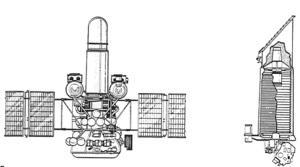Astron (spacecraft)
Topic: Engineering
 From HandWiki - Reading time: 4 min
From HandWiki - Reading time: 4 min
 | |
| Mission type | Astrophysical research |
|---|---|
| Operator | USSR |
| COSPAR ID | 1983-020A [1] |
| SATCAT no. | 13901 |
| Mission duration | 8 years |
| Start of mission | |
| Launch date | 23 March 1983 12:45 UTC |
| Rocket | Proton-K/D-1 8K82K/11S824M |
| Launch site | TYURATAM MISSILE AND SPACE COMPLEX |
| End of mission | |
| Disposal | Decommissioned |
| Deactivated | March 23, 1991 |
| Orbital parameters | |
| Reference system | Geocentric |
| Regime | High Earth |
| Semi-major axis | 108,531 km (67,438 mi)[1] |
| Eccentricity | 0.6575927[2] |
| Perigee altitude | 30,791.0 km (19,132.6 mi)[1] |
| Apogee altitude | 173,530.2 km (107,826.7 mi)[1] |
| Inclination | 48.4°[1] |
| Period | 5,930.5 minutes[1] |
| Mean motion | 0.24281115 rev/day[2] |
| Epoch | 19 July 2017 07:25:15 UTC |
Astron was a Soviet space telescope launched on 23 March 1983 at 12:45:06 UTC, using the Proton launcher.[3] Based on the 4MV spacecraft design and operational for six years, Astron was the largest ultraviolet space telescope of its time.
The project was headed by Alexandr Boyarchuk.[4][5] The spacecraft was designed and constructed by the Crimean Astrophysical Observatory and NPO Lavochkin. A group of scientists from these institutions was awarded the USSR State Prize for their work.[6]
The payload consisted of an 80 cm ultraviolet telescope, which was jointly designed by the USSR and France, and an X-ray spectroscope.[7] It could take UV spectra 150-350 nm.[8]
Placed into an orbit with an apogee of 185,000 kilometres (115,000 mi), Astron was capable of making observations outside the Earth's umbra and radiation belt.
Among the most important observations made by Astron were those of SN 1987A supernova from March 4 to March 12, 1987,[9] and of Halley's Comet in December 1985, the latter of which enabled a group of Soviet scientists to develop a model of the comet's coma.[10]
Operation of the observatory ended on 23 March 1991.[11]
See also
- Granat - a later space observatory based on the Venera spacecraft bus
References
- ↑ 1.0 1.1 1.2 1.3 1.4 1.5 "ASTRON". http://www.n2yo.com/satellite/?s=13901.
- ↑ 2.0 2.1 "TLE". http://celestrak.com/cgi-bin/TLE.pl?CATNR=13901.
- ↑ J. McDowell. "Jonathan McDowell's launchlog". Jonathan's Space Home Page. http://planet4589.org/space/log/launchlog.txt.
- ↑ "Spectr-UF Project History" (in ru). http://www.inasan.rssi.ru/rus/WSO/history.html.
- ↑ "Alexander Boyarchuk" (in ru). http://mirslovarei.com/content_bes/Bojarchuk-8125.html.
- ↑ "Crimean Astrophysical Observatory" (in ru). http://www.crimea-portal.gov.ua/index.php?&art=1107.
- ↑ "The Astron Satellite". NASA/GSFC. 26 June 2003. http://heasarc.gsfc.nasa.gov/docs/heasarc/missions/astron.html.
- ↑ Boyarchuk, A. A.; Grinin, V. P.; Zvereva, A. M.; Petrov, P. P.; Sheikhet, A. I. (1986). "A model for the coma of Comet Halley, based on the Astron ultraviolet spectrophotometry". Pis'ma v Astronomicheskii Zhurnal 12: 696. Bibcode: 1986PAZh...12..696B.
- ↑ A.A. Boyarchuk (1987). "Observations on Astron: Supernova 1987A in the Large Magellanic Cloud" (in ru). Pis'ma v Astronomicheskii Zhurnal 13: 739–743. Bibcode: 1987PAZh...13..739B.
- ↑ A.A. Boyarchuk (1986). "A model for the coma of Comet Halley, based on the Astron ultraviolet spectrophotometry" (in ru). Pis'ma v Astronomicheskii Zhurnal 12: 696–706. Bibcode: 1986PAZh...12..696B.
- ↑ Harvey, Brian; Zakutnyaya, Olga (2011). Russian Space Probes: Scientific Discoveries and Future Missions. Springer Praxis. pp. 376–380. ISBN 9781441981493.
- A.A. Бойарчук (1994) (in ru). Moscow: Nauka.
16 views | Status: cached on August 06 2024 05:56:57
↧ Download this article as ZWI file
 KSF
KSF
